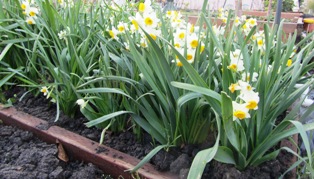Daffodils
William Wordsworth wrote, “A host of golden daffodils; beside the lake, beneath the trees, Fluttering and dancing in the breeze.”
These fragrant flowers evoke for me memories of growing up in rural Missouri where every spring, bulbs, in repetition of an ancient cycle, pushed upward through the earth with swordlike precision and flowered.
I’ve plucked some of these beauties for my desk. If I must work indoors, then I will enjoy their lovely yellow blooms where they rest in a vase upon my desk, which otherwise is piled high with books. I work. And every once in a while, I capture a whiff of their sweet scent permeating the room.
The following is a list of of several types of daffodils:
Trumpet daffodils (these include the King Alfred, Unsurpassable, and Beersheba (the latter is a white whereas the former has yellow blooms).
Large-cupped daffodils (Carlton, Fortune, Gertie Millar, and Tunis).
Jonquilla Hybrids (Trevithian)
Triandrus Hybrids (Thalia)
Double daffodils (Mary Copeland, White Lion, Twink)
Small-cupped daffodils (April Showers, Mrs. Nette O’Melveny)
Cyclalmineus Hybrids (February Gold)
Poeticus narcissus (Actaea, white flowers, yellow cups, edged in red)
Plant them in the fall in a location where they won’t be moved as they will increase in number each year. There are a lot of reasons to like daffodils: they give your garden color in the spring, the tolerate heat and cold, they are unappetizing to golphers, and they soon naturalize in the landscape.
 Facebook
Facebook Goodreads
Goodreads LinkedIn
LinkedIn Meera Lester
Meera Lester Twitter
Twitter





